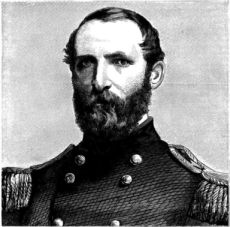Foster's Raid
See also: Battle of Kinston; Battle of Whitehall; Civil War
 In December 1862, with the Civil War in its second year, Brig. Gen. John G. Foster, the Union commander at New Bern, organized a large overland raid to Goldsboro to coincide with Maj. Gen. Ambrose E. Burnside's attack on Gen. Robert E. Lee's position at Fredericksburg, Va. The two Union commanders thus intended to prevent either Confederate force from reinforcing the other. The object of Foster's raid was to destroy the Wilmington & Weldon Railroad bridge over the Neuse River at Goldsboro, thus severing the rail line that was shipping valuable supplies from the port at Wilmington to Virginia.
In December 1862, with the Civil War in its second year, Brig. Gen. John G. Foster, the Union commander at New Bern, organized a large overland raid to Goldsboro to coincide with Maj. Gen. Ambrose E. Burnside's attack on Gen. Robert E. Lee's position at Fredericksburg, Va. The two Union commanders thus intended to prevent either Confederate force from reinforcing the other. The object of Foster's raid was to destroy the Wilmington & Weldon Railroad bridge over the Neuse River at Goldsboro, thus severing the rail line that was shipping valuable supplies from the port at Wilmington to Virginia.
On 11 Dec. 1862 Foster set out with 10,000 infantrymen, 640 cavalrymen, and 40 artillery pieces. At Kinston, he deployed his force to approach the town from an unanticipated direction on 13 December. A Confederate regiment briefly defended a partially destroyed bridge over a tributary of the Neuse River and then retreated to the main Confederate line two miles south of the bridge. Early on the morning of 14 December, Foster attacked the well-chosen Confederate position, outnumbering the enemy by more than five to one. The left side of the Confederate line collapsed and retreated across the bridge, mistakenly setting fire to it before the rest of their comrades could cross it. Consequently, 400 southerners were trapped and captured. Foster's men crossed the river and entered Kinston, the defenders retreating before them. Meanwhile, Burnside had met with a bloody repulse at Fredericksburg.
On the morning of 15 December, Foster recrossed the river and advanced westward, stopping for the night four miles outside of Whitehall (now Seven Springs) and sending a reconnaissance party with artillery support toward the town. This force encountered Confederate cavalry crossing the bridge over the Neuse River and setting fire to it. The Union artillery was unlimbered and began shelling the Confederates across the river. Damaged in the bombardment was the incomplete hull of the CSS Neuse, which was under construction there. Foster's main force arrived on 16 December and entered the fight, the massed Federal artillery sweeping the north side of the river from a commanding position. But the Confederates fought stubbornly before retreating at nightfall. On the same morning Foster had sent a detachment of New York cavalrymen to Mount Olive Station on the Wilmington & Weldon Railroad, where they dismantled a section of track.
After the Battle of Whitehall, Foster continued toward his main objective, nearing the railroad bridge at Goldsboro early on 17 December. He sent parties to Dudley Station and Everittsville to destroy railroad property in both locations. He also ordered five regiments to burn the railroad bridge at Goldsboro. Sheer firepower and weight of numbers forced the defenders on the south side of the river to retreat over a small span near the railroad bridge. As the Confederates hurried across the river, a Union lieutenant dashed for the bridge to put a torch to it. To prevent any attempt to save it, Foster trained all of his artillery on the bridge. When the vital bridge appeared to be engulfed in flames, the Federal soldiers returned to New Bern, believing that they had accomplished their mission.
Although Foster was satisfied with the success of the operation, damage to the bridge was merely superficial. Within two weeks the railroad was fully operational. The most significant damage from the raid was to personal property, crops, and livestock.
Reference:
John G. Barrett, The Civil War in North Carolina (1963).
Additional Resources:
Foster's Raid, NC Highway Historical Marker F-21: https://www.ncdcr.gov/about/history/division-historical-resources/nc-highway-historical-marker-program/Markers.aspx?ct=ddl&sp=search&k=Markers&sv=F-21%20-%20FOSTER%27S%20RAID
Foster's Raid, Civil War Traveler: http://www.civilwartraveler.com/EAST/NC/FostersRaid.html
History of the Battle at Goldsborough Bridge: http://goldsboroughbridge.org/history/
North Carolina as a Civil War battlefield, May 1862–November 1864. ANCHOR. https://www.ncpedia.org/anchor/north-carolina-civil-war-1
Image Credit:
Foster's Raid, NC Highway Historical Marker F-21. Image courtesy of NC Archives and History. Available from https://www.ncdcr.gov/about/history/division-historical-resources/nc-highway-historical-marker-program/Markers.aspx?ct=ddl&sp=search&k=Markers&sv=F-21%20-%20FOSTER%27S%20RAID (accessed November 1, 2012).
1 January 2006 | Blair, Dan